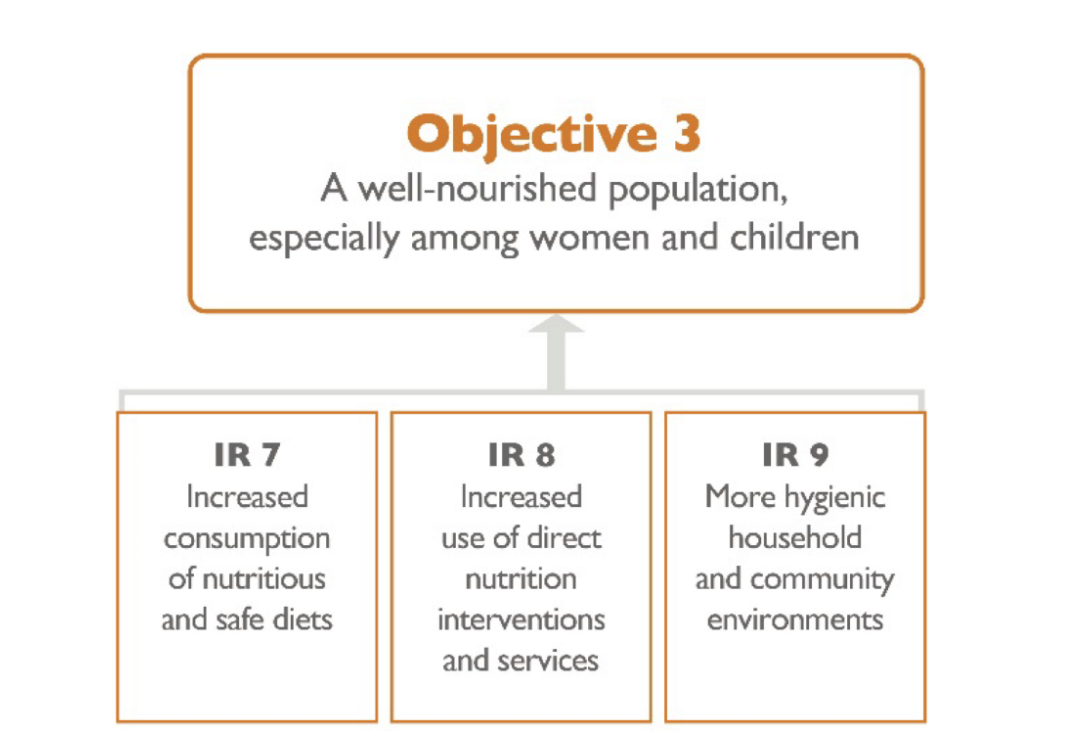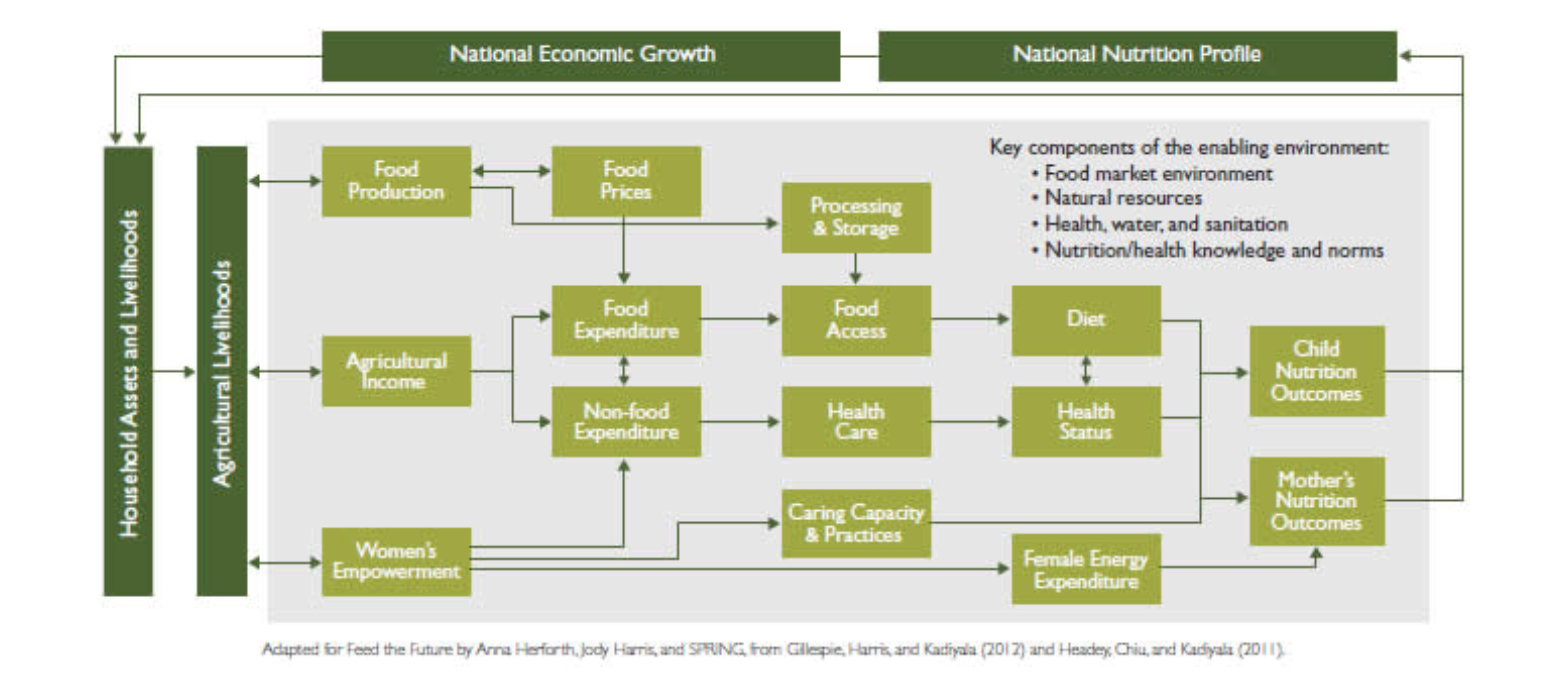Nutrition
Feed the Future (FTF) Global Food Security Strategy developed by 11 U.S. Government agencies and departments, presents an integrated approach to combating the root causes of hunger, malnutrition, and poverty and achieve a more food-secure future across the globe.

The strategy is accompanied by core technical guidance documents that provides a shared understanding of key concepts and best practices for designing and implementing Feed the Future programs under the Global Food Security Strategy and are core to achieving the three strategic objectives:
1.Inclusive and Sustainable Agricultural-Led Economic Growth
2.Strengthened Resilience among people and systems
3.A well-nourished population, especially among women and children
Nutrition is integral to achieving and sustaining food security, as reflected in the Global Food Security Act of 2016 and adopts the integrated approaches to nutrition laid out in USAID’s Multi-Sectoral Nutrition Strategy (MSNS) and the USG Global Nutrition Coordination Plan (GNCP).
The Nutrition Technical guidance document lays the foundation for designing new and follow-on integrated programming that incorporates nutrition objectives and technical approaches to optimize nutrition outcomes. It describes the best practices in nutrition programming in the context of the comprehensive approach called for in the GFSS, clarifies concepts, recommends programming principles, and provides links to technical resources for nutrition. This guidance on nutrition is intended to provide a framework for designing and implementing Feed the Future programs under the GFSS to achieve the Strategic Objective 3: A well-nourished population, especially among women and children as can be seen from the graphic below (Figure 1).

The GFSS Results Framework reflects a multi-sectoral nutrition approach to achieve Objective 3 that specifically targets women and children under five, with an emphasis on the 1000 day window of opportunity from pregnancy to a child’s second birthday, which is critical for optimum physical and cognitive development.
As illustrated in Figure 1, Objective 3 is achieved through three intermediate results (IRs 7-9). Optimal nutrition outcomes are often only achieved when nutrition-specific interventions (IR8) and nutrition-sensitive interventions (IR7 and IR9) are designed in close collaboration and coordination with each other, as all three intermediate results are necessary and important. Additional guidance for nutrition programming was developed under the MSNS and should be consulted as appropriate when designing nutrition activities in agriculture development projects.
For agricultural development activities to be more nutrition-sensitive, interventions must address BOTH the underlying and basic causes of malnutrition. Agriculture technologies and investments may improve availability and access to food, while also ensuring that producer households have income to pay for caregiving resources, and health care. The Primary Pathways for Improving Nutrition through Agriculture Technical Briefs highlight that a variety of nutrition-sensitive agriculture interventions may be needed to ultimately contribute to improving the nutrition of women and children (SPRING 2014). As illustrated by Figure 2 below, the pathways include:
- Food production, which can affect the food available for household consumption as well the price of diverse foods
- Agricultural income for expenditure on food and non-food items
- Women's empowerment, which affects income, caring capacity and practices, and female energy expenditure.
Acting on all of these routes is the enabling environment for nutrition, including several key components: the natural resources environment; the food market environment; the health, water, and sanitation environment; nutrition/ health knowledge and norms; and other factors, such as policy and governance.

The three pathways, ten programming principles and five policy principles explored in this USAID technical brief provide a summary of the current state of knowledge of ways to use agriculture to improve nutrition. While these pathways are not linear, and the interactions in some contexts are quite complex, the conceptual framework is a useful tool in design and implementation of nutrition-sensitive activities in agriculture programs. Making relevant changes (even if minor) to the design of an agricultural program can significantly improve nutrition outcomes.
For example, shifting focus from staple grains to more nutrient-rich foods such as legumes can improve dietary diversity and thus nutrition outcomes. Illustrative examples of potential nutrition-sensitive agriculture interventions as detailed in World Bank’s ‘Prioritizing Nutrition in Agriculture and Rural Development-Guiding Principles for Operational Investments’ is listed in Table 1 below.
| Nutrition outcome statement | Interventions that lead to the nutrition outcome |
|---|---|
| Increase dietary diversity |
|
| Increase micronutrient intake |
|
| Improve maternal and childcare and feeding |
|
| Protect health |
|
| Improve environment supportive of nutrition |
|
Quick Links
Resources on Legumes & Nutrition
Prioritizing Nutrition in Agriculture and Rural Development-Guiding Principles for Operational Investments – World Bank
Designing nutrition-sensitive agriculture investments. Checklist and guidance for programme formulation – UN World Food Programme
Guidance for nutrition-sensitive programming – UN World Food Programme
Global Nutrition Report Secretariat
USAID Policy & Regulations on Nutrition
USAID Global Food Security Strategy Technical Guidance on Nutrition (2017)
Multi-Sectoral Nutrition Strategy
USG Global Nutrition Coordination Plan
USAID SPRING -Strengthening Partnerships, Results, and Innovations in Nutrition Globally
Understanding and Supplying Primary Pathways and Principles
Improving Nutrition through Agriculture Technical Briefs
Understanding the Agricultural Income Pathway



